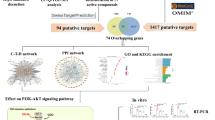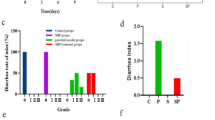Abstract
Diarrhea continues to be a major public health problem and is thought to be the cause of 525,000 child fatalities annually. Studies have shown that Macleaya cordata (Willd.) R.Br., Papaveraceae, has a good therapeutic effect on diarrhea due to its action on ion channels. However, its antidiarrheal mechanisms and key targets are not supported by scientific research. This study aimed to identify the mechanisms of action and targets of the primary active antidiarrheal compounds of M. cordata. We used network pharmacology and molecular docking to identify the antidiarrheal mechanisms and the key targets of M. cordata and its main chemical constituents. Subsequently, the experiments performed with dihydrosanguinarine (25, 50, and 100 mg/kg), which included the evaluation of the inhibitory potential of the epidermal growth factor receptor in osimertinib-induced diarrhea, real-time quantitative PCR, and western blotting, were performed for further verification of its mechanism of action. The findings revealed that of all the genes, tyrosine-protein kinase Lck, receptor tyrosine-protein kinase Erbb2, and epidermal growth factor receptor had the highest capacity of action, and the NF-kappa B and the calcium signaling pathways may play essential roles in M. cordata against diarrhea. Dihydrosanguinarine is the most active ingredient, and it significantly inhibits the increase in incidence and decreased the fecal water content of osimertinib-induced diarrhea. Western blot and qRT-PCR showed that dihydrosanguinarine works as an antidiarrheal agent by upregulating the expression of the core target epidermal growth factor receptor, affecting the NF-kappa B and the calcium ion signaling pathways, downregulating the expression of calcium-activated chloride channel and NK-kappa B P-65.
Graphical Abstract





Similar content being viewed by others
Data Availability
The data that support the finding of this study are available from the corresponding author upon reasonable request and some data that support the finding of this study are available in the supplementary material of this article.
References
Berridge MJ (2016) The inositol trisphosphate/calcium signaling pathway in health and disease. Physiol Rev 96:1261–1296. https://doi.org/10.1152/physrev.00006.2016
Bertrand J, Dannhoffer L, Antigny F, Vachel L, Jayle C, Vandebrouck C, Becq F, Norez C (2015) A functional tandem between transient receptor potential canonical channels 6 and calcium-dependent chloride channels in human epithelial cells. Eur J Pharm 765:337–345. https://doi.org/10.1016/j.ejphar.2015.08.005
Besra SE, Gomes A, Chaudhury L, Vedasiromoni JR, Ganguly DK (2002) Antidiarrhoeal activity of seed extract of Albizzia lebbeck Benth. Phytother Res 16:529–533. https://doi.org/10.1002/ptr.961
Chen YY, Li RY, Shi MJ, Zhao YX, Yan Y, Xu XX, Zhang M, Zhao XT, Zhang YB (2017) Demethyleneberberine alleviates inflammatory bowel disease in mice through regulating NF-κB signaling and T-helper cell homeostasis. Inflamm Res 66:187–196. https://doi.org/10.1007/s00011-016-1005-3
Emig D, Ivliev A, Pustovalova O, Lancashire L, Bureeva S, Nikolsky Y, Bessarabova M (2013) Drug target prediction and repositioning using an integrated network-based approach. PLoS ONE 8:e60618. https://doi.org/10.1371/journal.pone.0060618
Guedes IA, de Magalhães CS, Dardenne LE (2014) Receptor-ligand molecular docking. Biophys Rev 6:75–87. https://doi.org/10.1007/s12551-013-0130-2
Guo LY, Ai LW, Yang F, Liu WX, Hu WJ, Zhang XM, Sheng ZL, Gao CB (2022) Assessment of the antidiarrheal activity and chemical composition of dichloromethane extract from Macleaya cordata. Rev Bras Farmacogn 32:1009–1020. https://doi.org/10.1007/s43450-022-00337-8
Harada Y, Sekine H, Kubota K, Sadatomi D, Iizuka S, Fujitsuka N (2021) Calcium-activated chloride channel is involved in the onset of diarrhea triggered by EGFR tyrosine kinase inhibitor treatment in rats. Biomed Pharmacother 141:111860. https://doi.org/10.1016/j.biopha.2021.111860
Konkimalla VB, Efferth T (2010) Inhibition of epidermal growth factor receptor-overexpressing cancer cells by camptothecin, 20-(N, N-diethyl) glycinate. Bio Pharm 80:39–49. https://doi.org/10.1016/j.bcp.2010.02.022
Liang XJ, Li HY, Li S (2014) A novel network pharmacology approach to analyse traditional herbal formulae: the Liu-Wei-Di-Huang pill as a case study. Mol Biosist 10:1014–1022. https://doi.org/10.1039/c3mb70507b
Mcrorie J, Zorich N, Riccardi K, Bishop L, Filloon T, Wason S, Giannella (2000) Effects of olestra and sorbitol consumption on objective measures of diarrhea: impact of stool viscosity on common gastrointestinal symptoms. Regul Toxicol Pharmacol 39:59–67. https://doi.org/10.1006/rtph.1999.1368
Morris CJ, Corte DD (2021) Using molecular docking and molecular dynamics to investigate protein-ligand interactions. Mod Phys Lett B 35:21300027. https://doi.org/10.1142/S0217984921300027
Schroder B, Hoppe S, Breves G (2010) Evidence for down-regulation of neurogenic secretion in small intestinal epithelium from weaned piglets suffering from diarrhea. Livest Sci 133:218–221. https://doi.org/10.1016/j.livsci.2010.06.068
Sun MS, Zhong XH, Zhou L, Xu ZX, Huang P, Zeng JG (2022) Plant-microbe hybrid synthesis provides new insights for the efficient use of Macleaya cordata. World J Microb Biot 38:110. https://doi.org/10.1007/s11274-022-03295-4
Tao G, Chityala PK (2021) Epidermal growth factor receptor inhibitor-induced diarrhea: clinical incidence, toxicological mechanism, and management. Toxicol Res 10:476–486. https://doi.org/10.1093/toxres/tfab026
Tietcheu GBR, Ayissi OVB, Guemmogne TRJ, Metzger K, Atsama AM, Djamen CPD, Fondjo KA, Ngounoue DM, Aliouat DCM, Cocquerel L, Fewou MP (2021) In silico and in vitro screening of licensed antimalarial drugs for repurposing as inhibitors of hepatitis E virus. In: Silico Pharmacol 9:35. https://doi.org/10.1007/s40203-021-00093-y
Wahid M, Saqib F, Ahmedahm HT, Gavris CM, Feo VD, Hogea M, Moga M, Chicea R (2021) Cucumis sativus L. seeds smeliorate muscular spasm-induced gastrointestinal and respiratory disorders by simultaneously inhibiting calcium mediated signaling pathway. Pharm 14:1197. https://doi.org/10.3390/ph14111197
Wang F, Yin YX, Yang M, Chen JS, Fu CX, Huang K (2021) Effects of combined supplementation of Macleaya cordata extract and benzoic acid on the growth performance, immune responses, antioxidant capacity, intestinal morphology, and microbial composition in weaned piglets. Front Vet Sci 8:708597. https://doi.org/10.3389/fvets.2021.708597
Xu QQ, Shen ZQ, Wang YB, Guo SJ, Li F, Wang YP, Zhou CF (2013) Anti-diarrhoeal and anti-microbial activity of Flos populi (male inflorescence of Populus tomentosa Carriere) aqueous extracts. J Ethnopharmacol 148:640–646. https://doi.org/10.1016/j.jep.2013.05.021
Yakoob MY, Theodoratou E, Jabeen A, Imdad A, Eisele TP, Ferguson J, Jhass A, Rudan I, Campbell H, Black RE, Bhutta ZA (2011) Preventive zinc supplementation in develo** countries: impact on mortality and morbidity due to diarrhea, pneumonia and malaria. BMC Public Health 11:S23. https://doi.org/10.1186/1471-2458-11-S3-S23
Yokota H, Sato K, Sakamoto S, Okuda Y, Asano M, Takeda M, Nakayama K, Miura M (2021) Relationship between plasma concentrations of afatinib and the onset of diarrhea in patients with non-small cell lung cancer. Biology 10:1054. https://doi.org/10.3390/biology10101054
Yu Z, Wu Z, Li W, Liu G, Tang Y (2022a) ADENet: a novel network-based inference method for prediction of drug adverse events. Brief Bioinform 23:bbab580. https://doi.org/10.1093/bib/bbab580
Yu CY, Wang D, Yang ZB, Wang T (2022b) Pharmacological effects of polyphenol phytochemicals on the intestinal inflammation via targeting TLR4/NF-kappa B signaling pathway. Int J Mol Sci 23:6939. https://doi.org/10.3390/ijms23136939
Funding
Dr. Zunlai Sheng is supported by the National Natural Science Foundation of China (Grant No. 32373057). Dr. Chunli Chen is supported by the 2022 ESI International High Impact Research Article Cooperation Program (No. 212–54900112), the National Natural Science Foundation of Heilongjiang Province (No. YQ2022C017), and the International Postdoctoral Exchange Fellowship Program from the Office of China Postdoctoral Council (No. 2020106 and PC2020013).
Author information
Authors and Affiliations
Contributions
LG, CC, and ZS conceived and designed the study. LG and XX performed the experiments. CC and YZ acquired the data. LG, XX, and YZ analyzed the data. LG drafted and critically revised the article. LG, XX, YZ, CC, and ZS proofread the final manuscript.
Corresponding authors
Ethics declarations
Ethics Approval
The authors declare that the procedures followed were in accordance with the regulations of the relevant clinical research ethics committee and with those of the Code of Ethics of the World Medical Association (Declaration of Helsinki).
Supplementary Information
Below is the link to the electronic supplementary material.
Rights and permissions
Springer Nature or its licensor (e.g. a society or other partner) holds exclusive rights to this article under a publishing agreement with the author(s) or other rightsholder(s); author self-archiving of the accepted manuscript version of this article is solely governed by the terms of such publishing agreement and applicable law.
About this article
Cite this article
Guo, L., Xue, X., Zhou, Y. et al. Deciphering the Antidiarrheal Mechanisms of Macleaya cordata by Combining Network Pharmacology, Molecular Docking, and Experimental Evaluations. Rev. Bras. Farmacogn. 34, 637–646 (2024). https://doi.org/10.1007/s43450-024-00514-x
Received:
Accepted:
Published:
Issue Date:
DOI: https://doi.org/10.1007/s43450-024-00514-x




